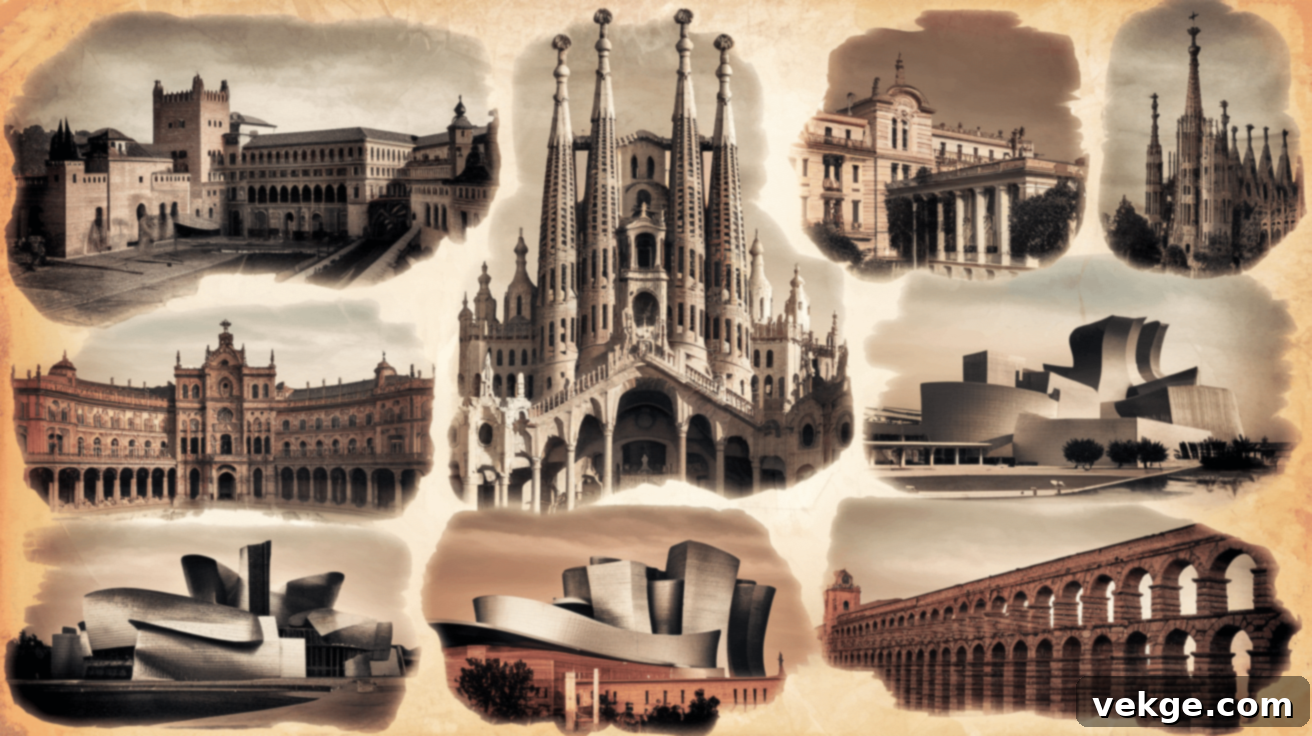Discover Spain’s Architectural Wonders: A Guide to Its Most Famous Buildings
Spain is a land brimming with some of the world’s most breathtaking architecture. With such a wealth of incredible structures spanning millennia, deciding where to begin your exploration can be a delightful challenge.
Whether you’re a devoted history buff, a passionate architecture enthusiast, or simply a curious traveler, narrowing down the must-see buildings can feel daunting. This comprehensive guide highlights 20 of the most famous Spanish architectural wonders, taking you on a journey from ancient Roman structures to futuristic modern masterpieces.
We’ll delve into the captivating evolution of Spain’s architecture, showcasing the diverse styles that have profoundly shaped its rich cultural and historical landscape. By the end, you’ll gain a deeper appreciation for Spain’s architectural gems and possess a curated list of exactly which iconic landmarks to visit. Get ready to experience Spain through its most celebrated and awe-inspiring buildings!
A Timeline of Spanish Architecture Styles
Spain’s buildings are more than just structures; they are living chronicles of its ancient cultures and diverse civilizations. Over centuries, countless creators and conquerors have left their indelible mark, shaping its unique and ever-evolving architectural identity. Each structure represents a distinct era in history, reflecting the societal values, technological capabilities, and artistic expressions of its time. From the enduring strength of Roman roads to the innovative curves of modern designs, Spanish buildings stand as tangible examples of a rich and layered past.
Pre-Roman and Roman Influence
The very foundations of Spanish architecture are deeply rooted in the remarkable engineering prowess of the Roman Empire. Their ambition and technical skill are still evident in the monuments that dot the Iberian Peninsula.
The Segovia Aqueduct stands as an extraordinary testament to Roman construction skill. This monumental structure, with its dual-tiered arches, stretches for nearly 30 kilometers. Amazingly built without a single drop of mortar, its massive granite blocks remain perfectly balanced and structurally sound after two millennia, defying gravity and time.
The Roman Theater in Mérida, another marvel, perfectly demonstrates the technical expertise of these ancient builders. Its carefully designed acoustics allow voices to carry throughout the entire space without any form of amplification, a true feat of engineering. The expansive structure includes an orchestra pit, a grand stage, and tiered seating capable of accommodating thousands of spectators, underscoring its importance as a center for entertainment and culture.
Beyond public works, Roman villas scattered across the Spanish countryside offer glimpses into daily life, featuring exquisite mosaic floors that display intricate geometric patterns and vibrant scenes from mythology. These luxurious homes were even equipped with advanced heating systems, known as hypocausts, where hot air circulated beneath raised floors, providing warmth during colder months.
Moorish and Mudéjar Architecture
The arrival of Islamic rulers in Spain (Al-Andalus) ushered in an era of incredible architectural innovation and artistic sophistication. This period introduced styles that are distinctly elegant, intricate, and deeply influential.
The Alhambra in Granada is often considered the pinnacle of this artistic genius. Its palace walls are adorned with incredibly detailed stucco work, featuring complex mathematical patterns that repeat infinitely, reflecting Islamic principles of harmony and order. The famous Court of the Lions captivates with its central fountain supported by twelve marble lions, each one uniquely carved, a masterpiece of sculpture and hydraulic engineering.
The Mosque-Cathedral of Córdoba represents another breathtaking masterpiece, a unique blend of Islamic and Christian architectural elements forged over centuries. Its mesmerizing ‘forest’ of columns creates a hypnotic interior space, with distinctive striped arches that seem to extend infinitely in every direction, drawing the eye upwards. The mihrab, or prayer niche, within the mosque section, showcases some of the most detailed and vibrant Byzantine mosaics in all of Spain, gleaming with gold and intricate patterns.
The Giralda Tower in Seville, originally built as the minaret for the Great Mosque of Seville, later incorporated bell tower elements after the Christian Reconquista. Its unique design features ramps rather than stairs, allowing officials to ascend on horseback to the top for the call to prayer, demonstrating practical design alongside aesthetic grandeur.
Gothic and Romanesque Churches
Medieval Spanish architecture reached new, towering heights through the construction of magnificent religious buildings, primarily Romanesque and Gothic cathedrals and churches. These structures were symbols of faith and power, pushing the boundaries of construction technology.
The Santiago de Compostela Cathedral, a paramount pilgrimage site, beautifully showcases both Romanesque and Gothic elements. Its iconic Pórtico de la Gloria (Portico of Glory) contains over 200 intricately carved figures that appear to move and interact with one another, depicting biblical narratives with incredible dynamism. The building’s robust granite exterior has acquired a distinctive, rich patina from centuries of exposure to rain and sun, adding to its ancient charm.
Toledo Cathedral represents another architectural marvel of the Gothic era, with its soaring arches, dramatic buttresses, and elaborate stone carvings that vividly narrate stories of faith, history, and unparalleled artistic skill. A highlight is “El Transparente,” an ornate Baroque skylight and altarpiece that brings natural illumination to the high altar through a clever arrangement of windows and openings, creating a stunning visual effect. The cathedral’s sacristy also houses invaluable works by master painters like El Greco, Goya, and Velázquez.
Burgos Cathedral stands as one of Spain’s most comprehensive and stunning Gothic structures. Its delicate spires reach majestically skyward, while a network of flying buttresses allows for immense stained-glass windows that flood the interior with a kaleidoscope of colored light, creating an ethereal and uplifting atmosphere.
Renaissance and Baroque Periods
During the Renaissance and Baroque eras, Spanish architecture evolved to become more ornate, dramatic, and imbued with a sense of grandeur and imperial power, reflecting Spain’s status as a global empire.
The Royal Palace of Madrid magnificently demonstrates the splendor of this period with its imposing facade and intricately designed interiors. This vast palace contains more than 3,000 rooms, each lavishly decorated with frescoes, tapestries, and elaborate plasterwork. Its main staircase, crafted from a single piece of lustrous San Agustín marble, serves as a grand focal point for visitors, embodying the opulence of the Spanish monarchy.
Seville Cathedral, though started in the Gothic period, also incorporates significant Renaissance and Baroque elements, emerging as another significant landmark showcasing the architectural ambition of the time. Its massive interior is so vast that it is said an entire medieval church could fit within its central nave. It famously houses the elaborate tomb of Christopher Columbus, carried by four majestic figures representing the historical kingdoms of Castile, León, Aragon, and Navarre.
The Plaza Mayor in Madrid brilliantly exemplifies urban planning from this period. Surrounded by uniform buildings with consistent facades and red-brick and slate roofs, the square creates a harmonious outdoor “room” designed for public gatherings, markets, and royal celebrations, showcasing an organized and grand urban aesthetic.
Modernism and Antoni Gaudí
No discussion of Spanish architecture is complete without a deep dive into the revolutionary contributions of Antoni Gaudí, whose visionary designs profoundly changed Barcelona’s urban landscape and indeed, the course of modern architecture.
The Sagrada Família, still under construction over a century after Gaudí began it, represents his most ambitious and famous work. Its distinctive, organic towers seem to grow naturally from the base, while light filters through vibrant colored glass to create an ever-changing, almost spiritual atmosphere throughout the day. The basilica is a symphony of natural forms, intricate symbolism, and structural innovation.
Casa Milà (La Pedrera) and Casa Batlló further exemplify his unique approach, blending organic shapes with incredible artistic and symbolic details. Casa Batlló’s facade appears to shimmer and undulate in different lights, with balconies resembling masks or skulls and a roof that evokes a dragon’s back. Casa Milà, famously known as “La Pedrera” (the stone quarry) due to its rough-hewn appearance, contains virtually no straight lines, instead following the flowing, curved forms found everywhere in nature.
Park Güell demonstrates Gaudí’s unparalleled ability to seamlessly integrate architecture with the natural landscape. Its iconic curved benches are ergonomically designed to follow the contours of the human body, while columns mimic ancient tree trunks supporting the weight above, creating a whimsical and harmonious public space adorned with colorful mosaic work (trencadís).
20 Must-See Architectural Buildings in Spain
1. Alhambra, Granada
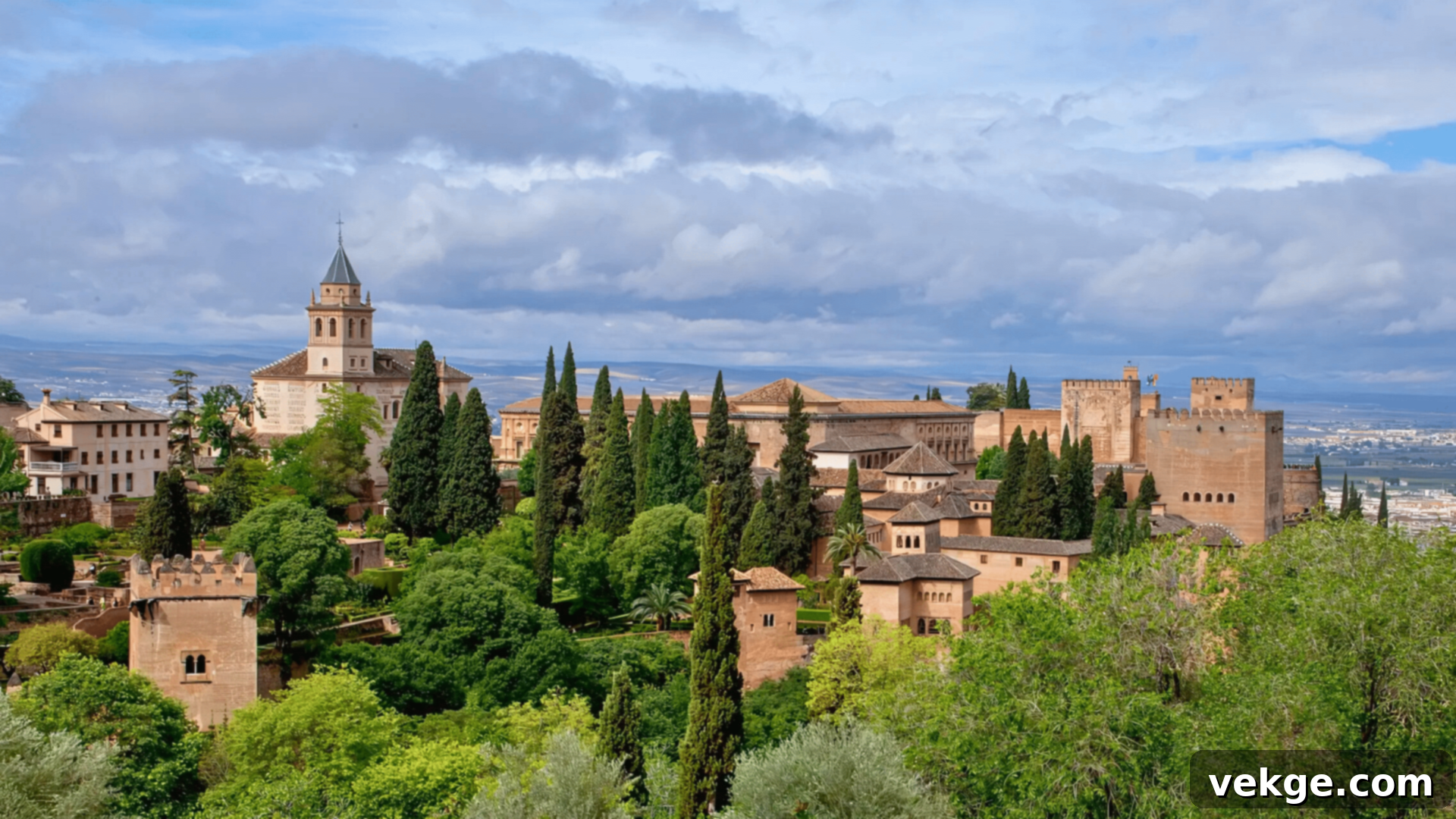
The Alhambra stands as a powerful symbol of Spain’s rich Islamic heritage and a masterpiece of Moorish design. This magnificent palace and fortress complex captures the imagination with its intricate architectural details, stunning gardens, and deep historical significance, representing the height of artistic achievement in the Iberian Peninsula.
- Year built: 14th century
- Style: Moorish architecture
- Key feature: A UNESCO World Heritage site with breathtaking Islamic design, including intricate stucco, tilework, and serene courtyards.
2. Sagrada Família, Barcelona
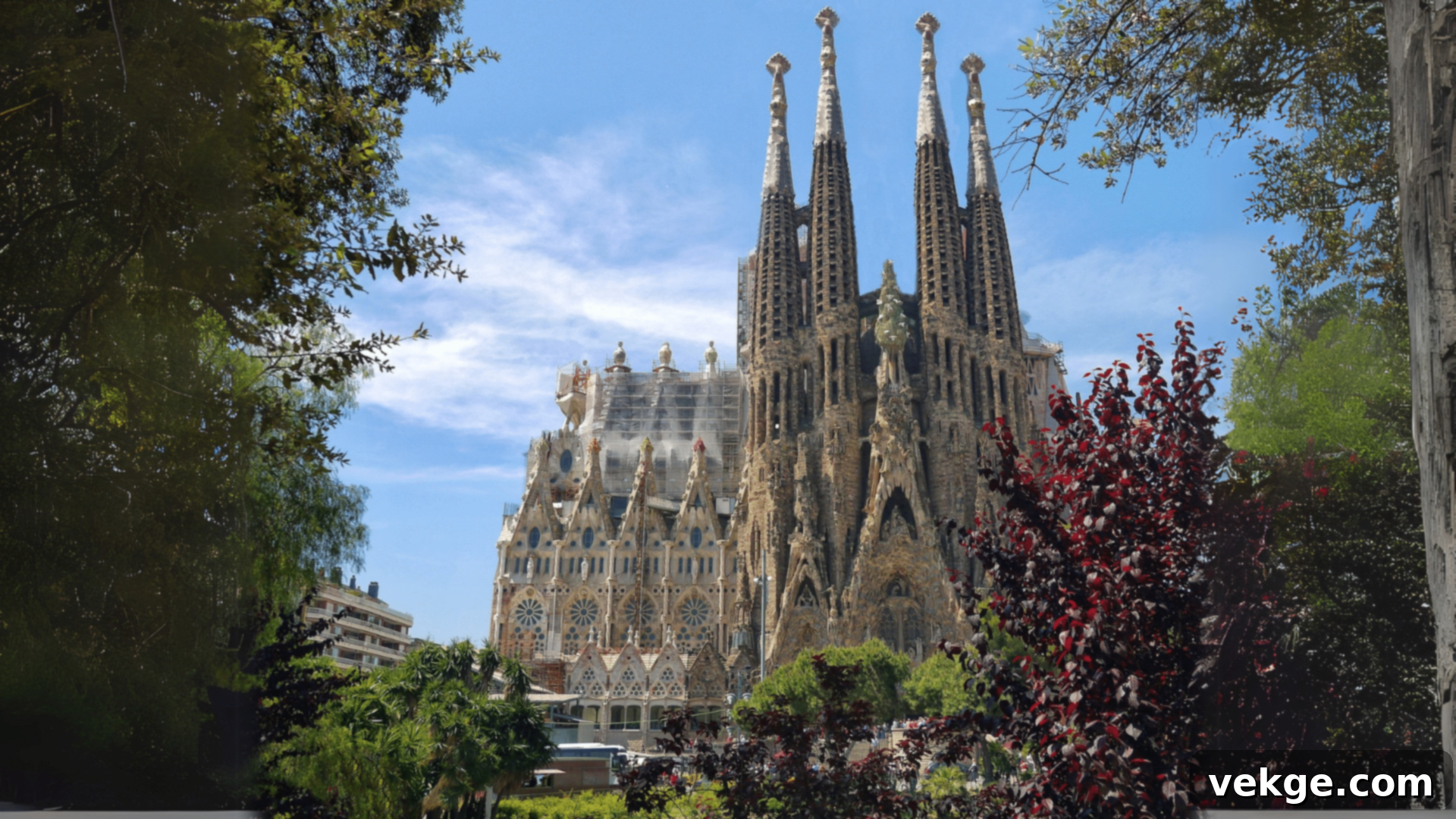
Antoni Gaudí’s most famous work continues to inspire and amaze visitors from around the globe. This extraordinary basilica has been under construction for over a century, embodying the power of architectural vision and persistent creativity. Its unique, organic design challenges traditional architectural boundaries, making it an icon of Barcelona.
- Year built: Started 1882, ongoing
- Style: Modernist style
- Key feature: Gaudí’s unfinished masterpiece, renowned for its incredible organic details, symbolic facades, and innovative structural solutions.
3. Royal Palace of Madrid
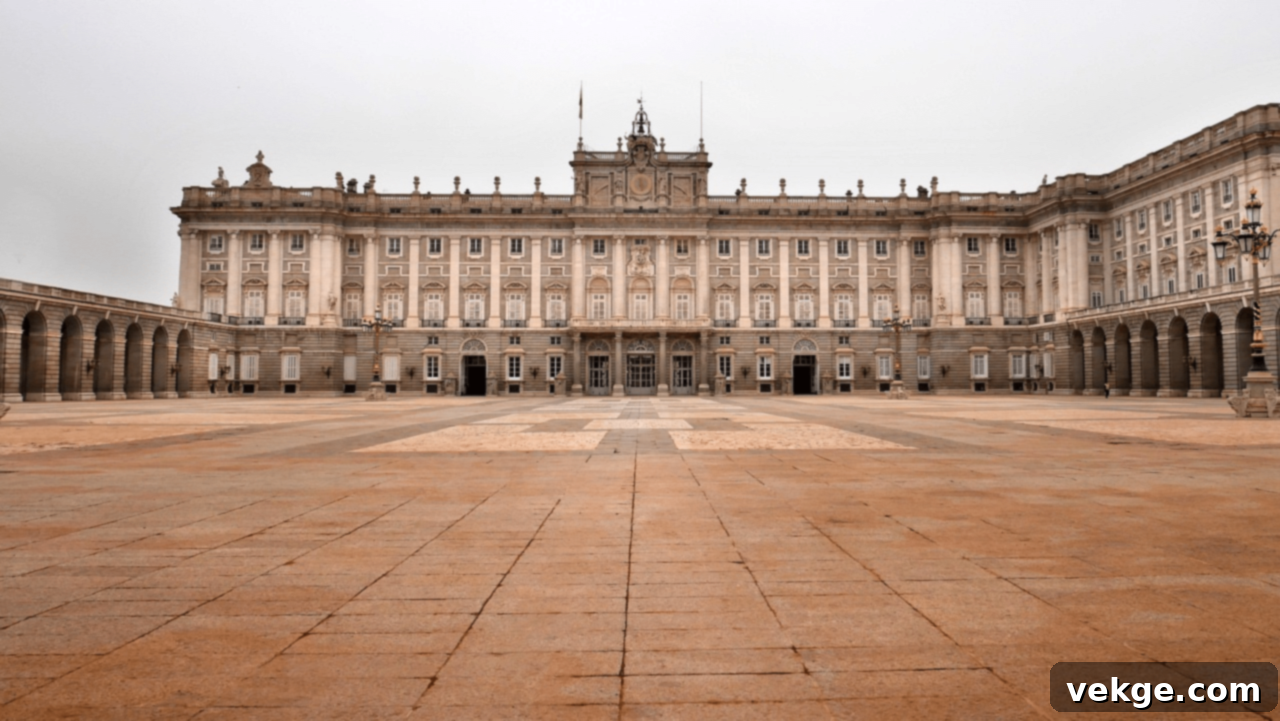
A symbol of Spanish royal history and grandeur, this magnificent palace represents the opulence and power of Spain’s monarchical past. Its impressive Baroque architecture and richly decorated interiors tell vivid stories of royal life, national heritage, and artistic patronage.
- Year built: 18th century
- Style: Baroque style
- Key feature: One of the largest royal palaces in Europe, featuring over 3,000 exquisitely decorated rooms.
4. Mezquita of Córdoba
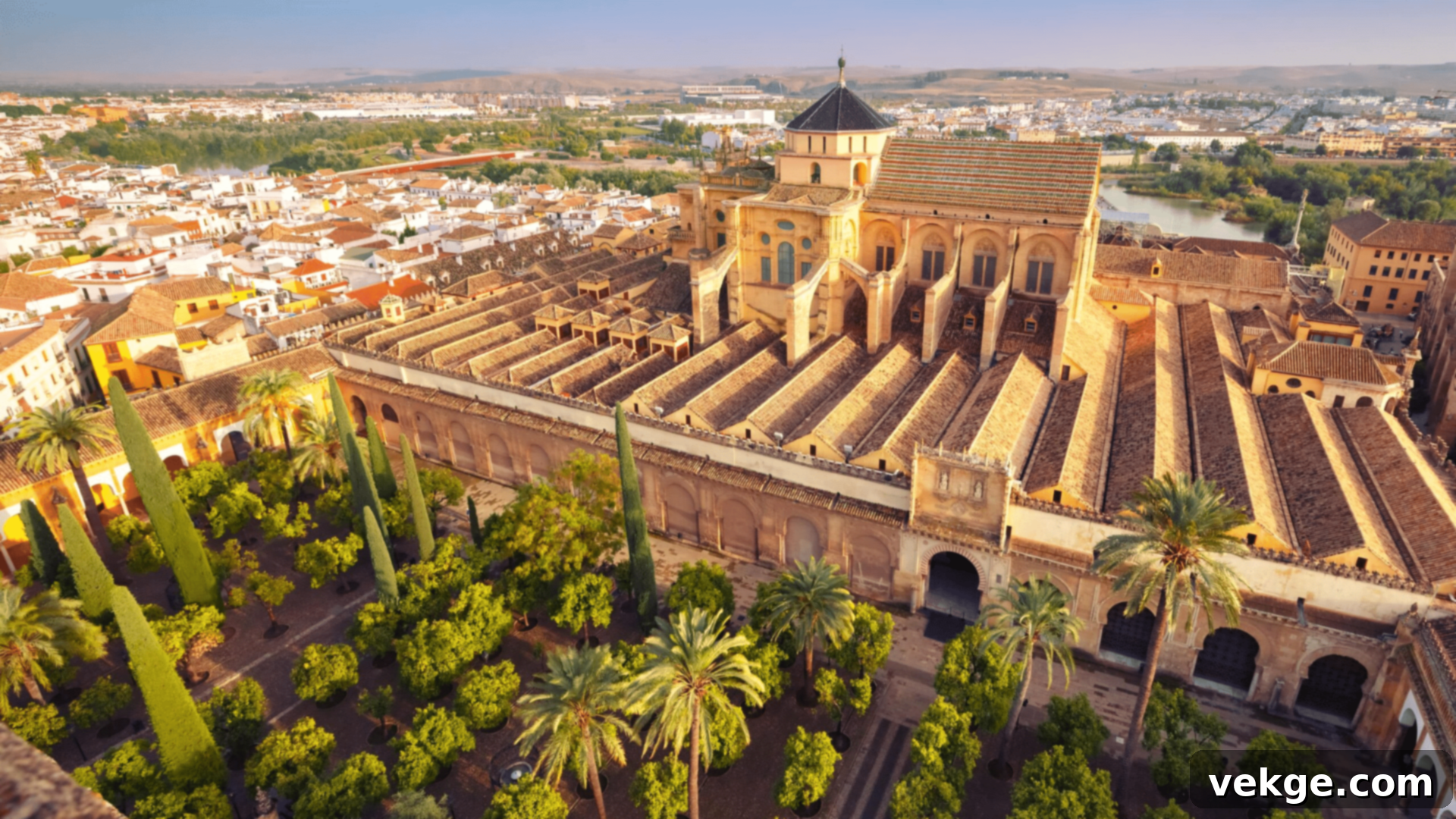
This remarkable building uniquely illustrates the complex religious and cultural history of Spain. A truly one-of-a-kind structure that began as a grand mosque and was later converted into a cathedral, it stands as a powerful symbol of cultural interchange, architectural adaptation, and historical layering.
- Year built: 8th-10th century (mosque), later additions
- Style: Islamic and Christian architecture
- Key feature: A unique mosque-cathedral hybrid, famous for its mesmerizing interior ‘forest’ of horseshoe arches and columns.
5. Santiago de Compostela Cathedral
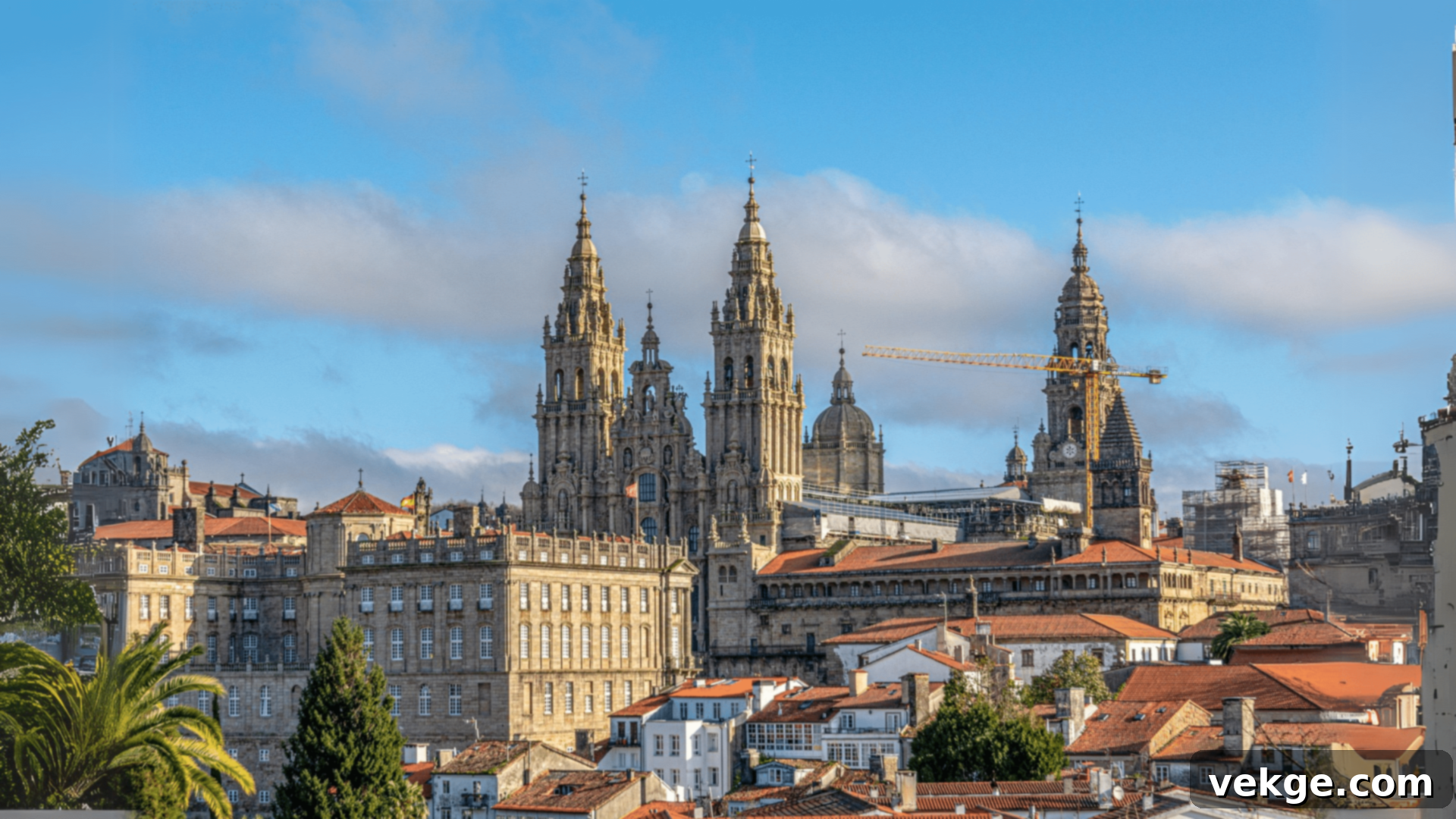
A cornerstone of Christian pilgrimage and the revered destination of the Camino de Santiago, this cathedral represents centuries of spiritual and architectural history. Its stone facade and intricate porticos tell profound stories of faith, art, and human dedication, drawing millions of pilgrims over the centuries.
- Year built: 11th-12th century
- Style: Romanesque and Gothic
- Key feature: An immensely important pilgrimage site with an elaborate stone facade, including the famed Pórtico de la Gloria.
6. Guggenheim Museum, Bilbao

Frank Gehry’s masterpiece revitalized the city of Bilbao and redefined modern architectural possibilities on a global scale. Its flowing, titanium-clad surfaces create a dynamic dialogue between architecture, sculpture, and the urban space, often described as a ship or a metallic flower.
- Year built: 1997
- Style: Contemporary deconstructivist design
- Key feature: A groundbreaking structure that reshaped the city’s architectural landscape with its iconic curved metal surfaces and innovative form.
7. Casa Batlló, Barcelona
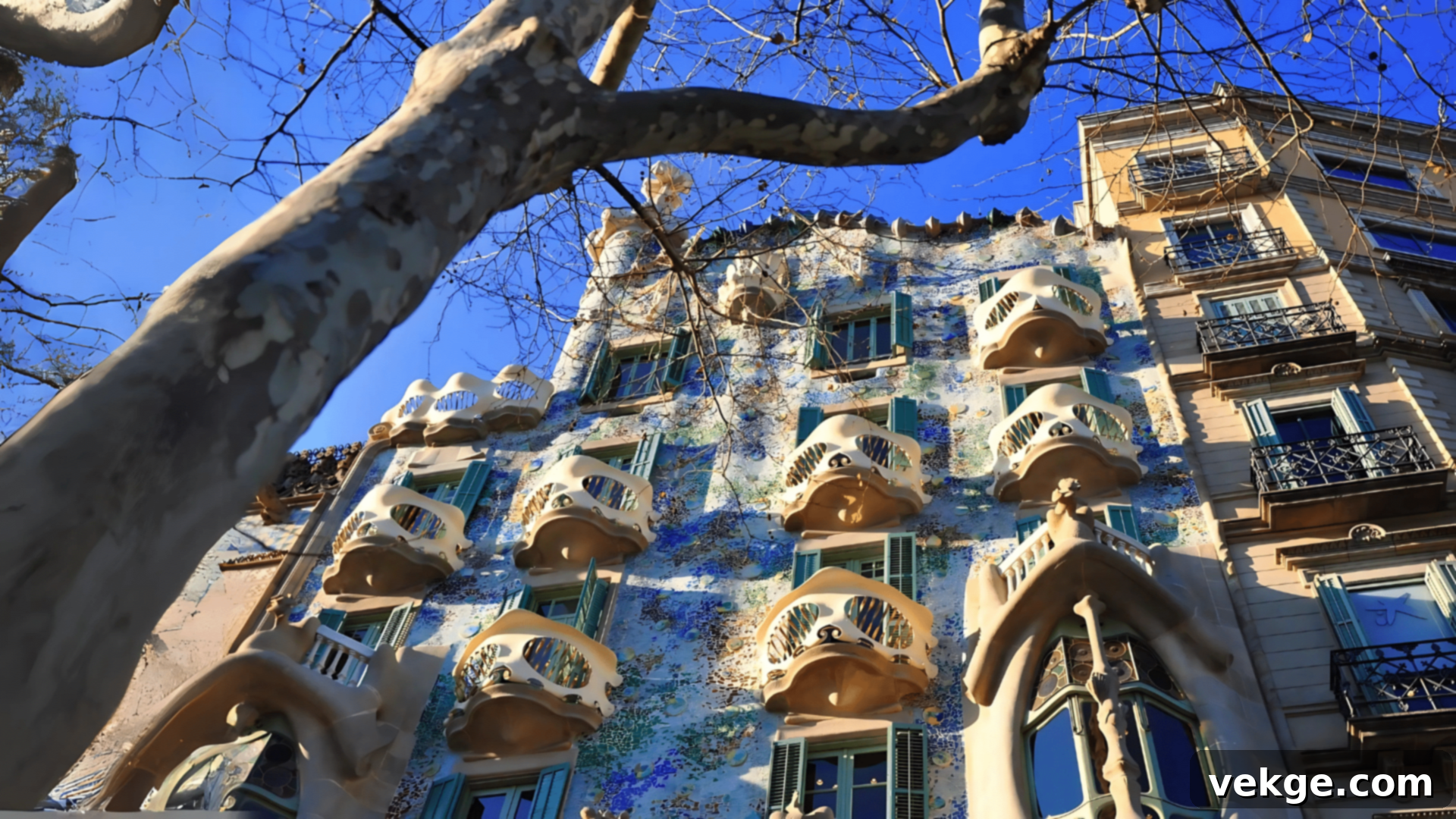
Another Gaudí gem, this whimsical building pushes the boundaries of traditional architectural design with its organic forms and unique aesthetic. Often referred to as the “House of Bones,” its fantastical appearance challenges viewers to reimagine what a building can be, reflecting a deep connection to nature.
- Year built: Modernized in early 1900s by Gaudí
- Style: Gaudí’s unique Modernist style
- Key feature: A fantastical facade that looks like it’s made from bones, scales, and vibrant mosaics, embodying organic surrealism.
8. City of Arts and Sciences, Valencia
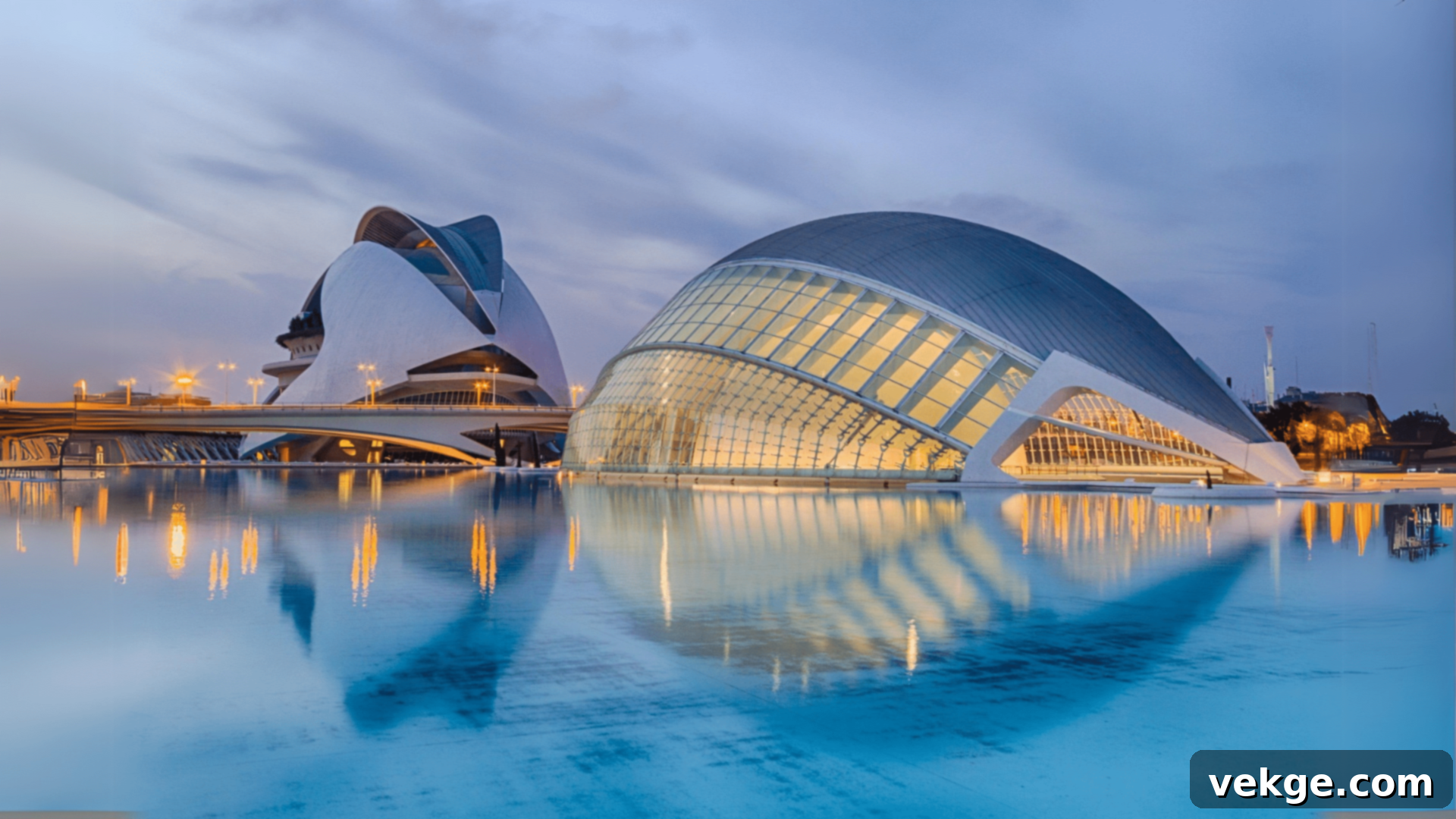
A breathtaking, forward-thinking complex that represents the cutting edge of architectural innovation by Santiago Calatrava. Its striking white structures seem to defy gravity, creating a surreal landscape that looks more like a scene from science fiction than a traditional urban park.
- Year built: Late 1990s-early 2000s
- Style: Futuristic design, structural expressionism
- Key feature: Monumental white structures that appear to float, housing a science museum, opera house, and oceanarium.
9. Toledo Cathedral
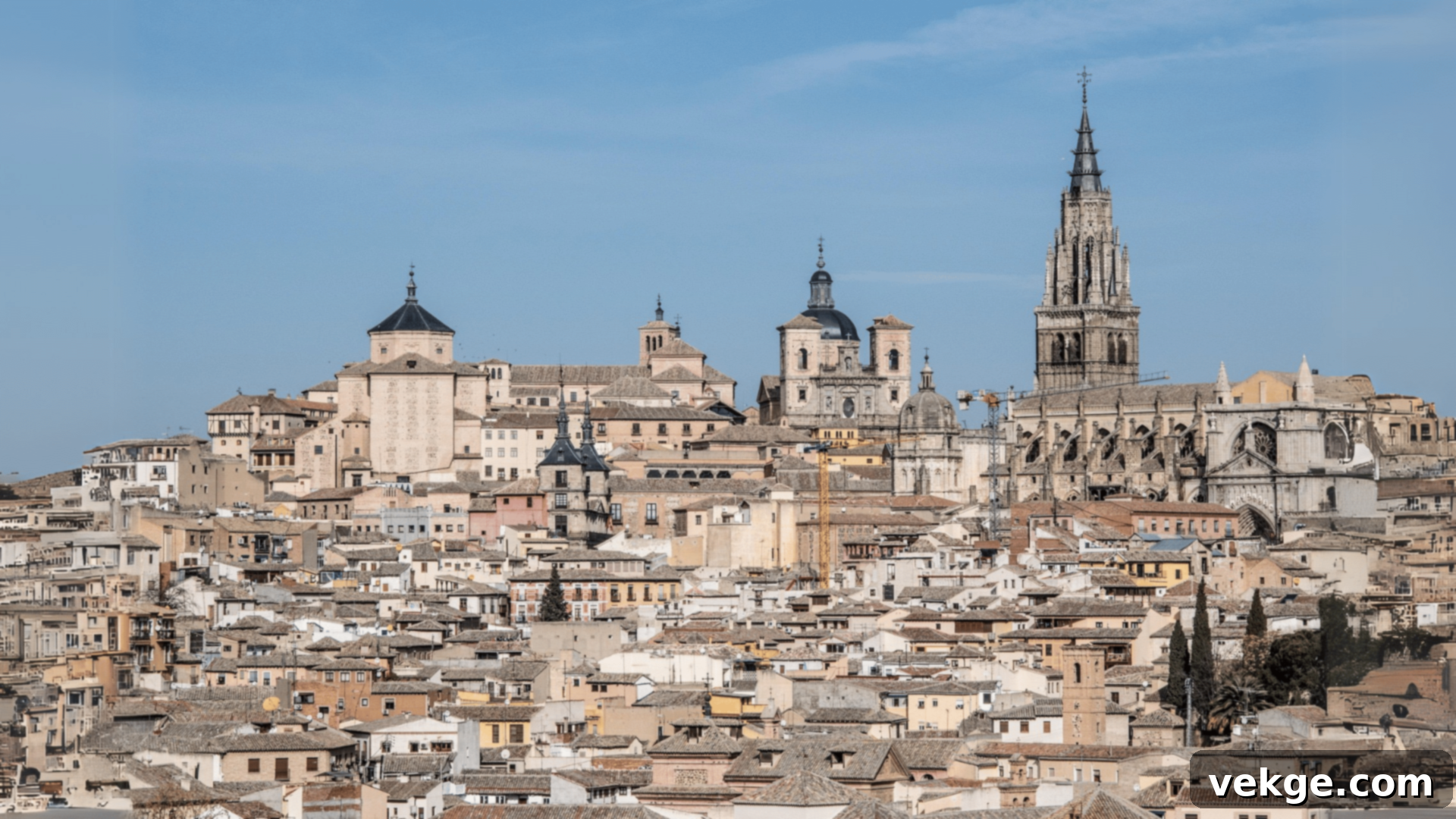
A true masterpiece of Gothic architecture, this cathedral stands as a testament to medieval architectural skill, religious devotion, and artistic ambition. Its massive structure and towering spires dominate the historic Toledo skyline, making it an unmistakable landmark.
- Year built: 13th-15th century
- Style: Gothic style
- Key feature: A massive cathedral renowned for its incredible stained glass, soaring arches, and the unique “El Transparente” altarpiece.
10. La Pedrera (Casa Milà), Barcelona
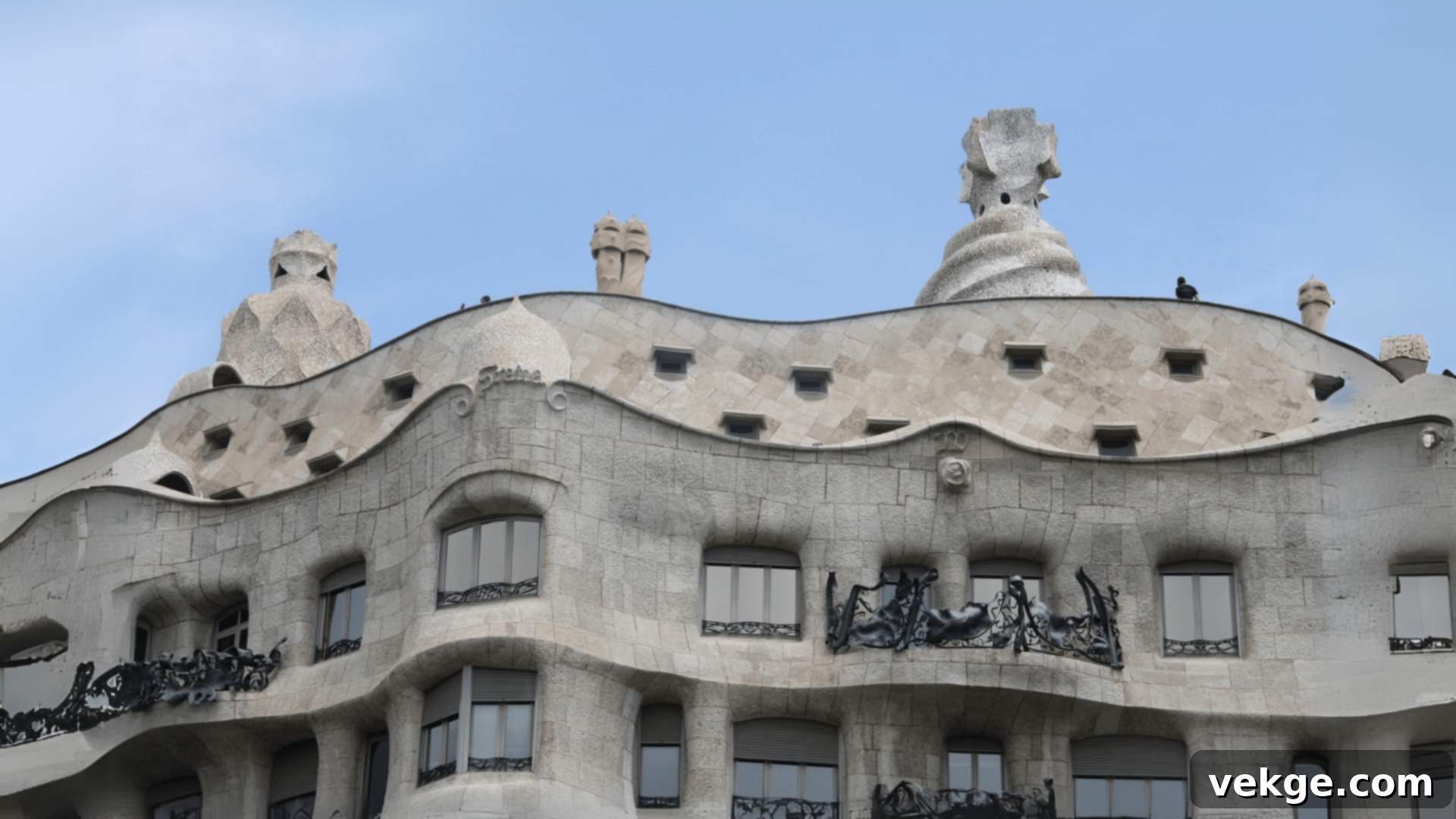
Gaudí’s residential masterpiece, Casa Milà (popularly known as La Pedrera, or “The Quarry”), challenges conventional building design with its undulating facade and unique interior. It brilliantly showcases the architect’s revolutionary approach to space, form, and natural inspiration, devoid of any straight lines.
- Year built: Early 1900s
- Style: Modernist architecture
- Key feature: A wavy stone facade that resembles a rocky cliff, featuring organic forms and a distinctive rooftop with sculptural chimneys.
11. Seville Cathedral
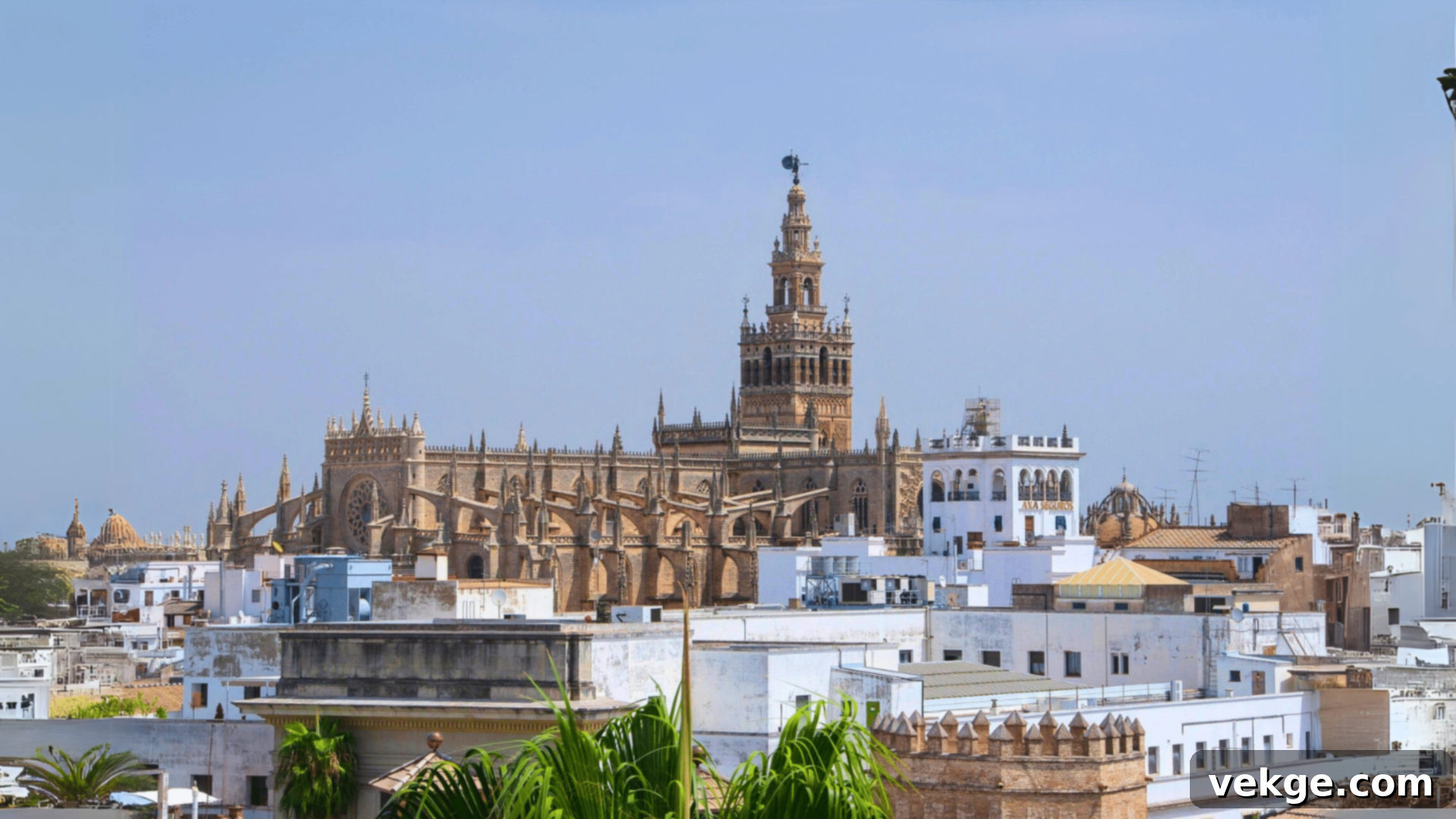
As the world’s largest Gothic cathedral and a UNESCO World Heritage site, Seville Cathedral stands as a monumental achievement of architectural and religious significance. Its massive scale, intricate details, and the iconic Giralda bell tower continue to inspire awe and draw visitors from across the globe.
- Year built: 15th-16th century
- Style: Gothic and Renaissance
- Key feature: The world’s largest Gothic cathedral, built on the site of a former mosque, featuring the stunning Giralda minaret-turned-bell tower.
12. Alcázar of Segovia
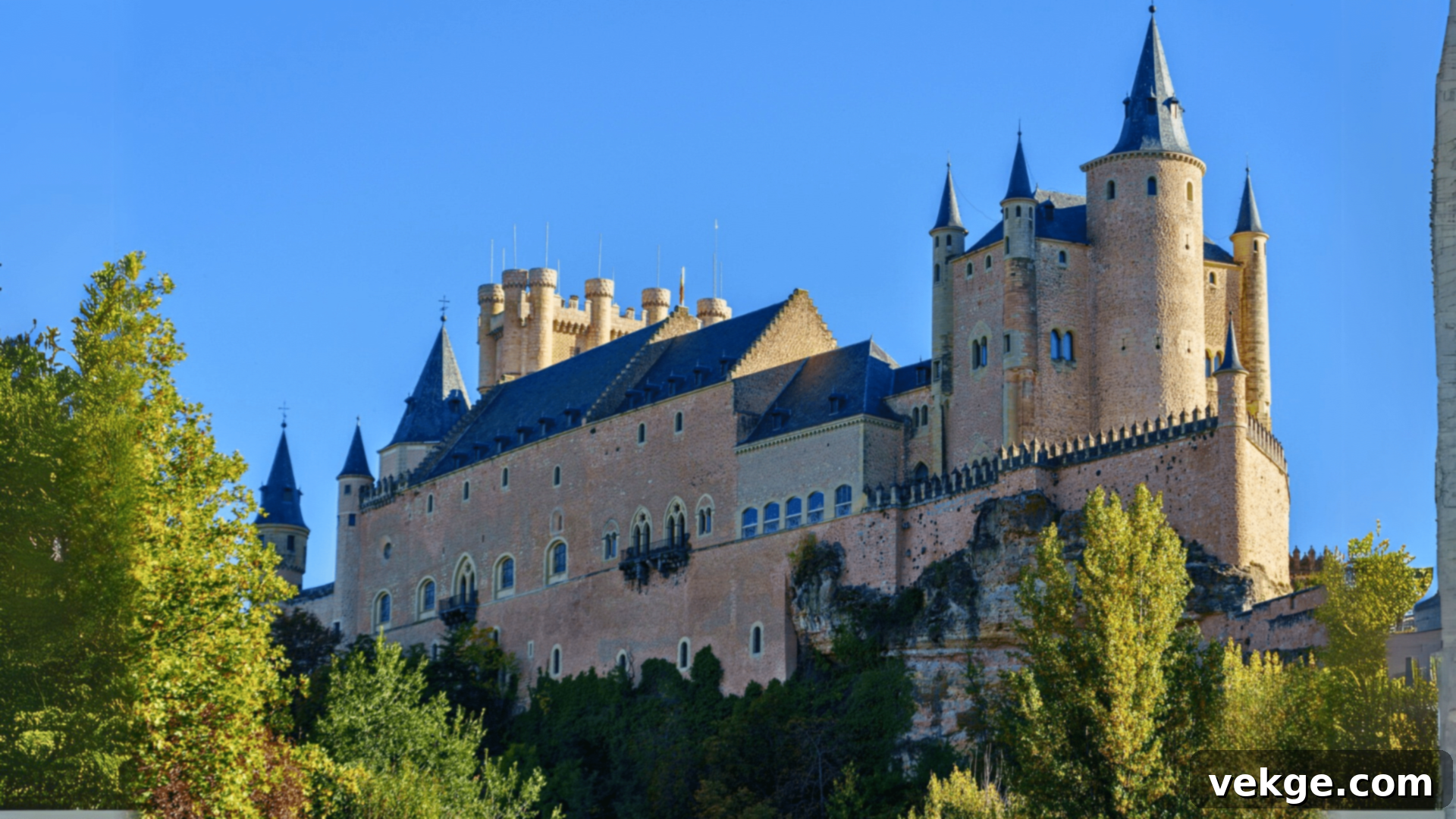
Resembling a fairytale castle that seems to spring directly from a storybook, this historic fortress combines formidable military architecture with royal elegance. Its unique and instantly recognizable silhouette, perched majestically on a hilltop, has inspired countless artists and even Disney.
- Year built: 11th century, rebuilt 15th century
- Style: Medieval castle, Gothic, Mudéjar elements
- Key feature: A stunning, iconic castle on a hilltop, known for its distinctive turrets and rich royal history.
13. Park Güell, Barcelona
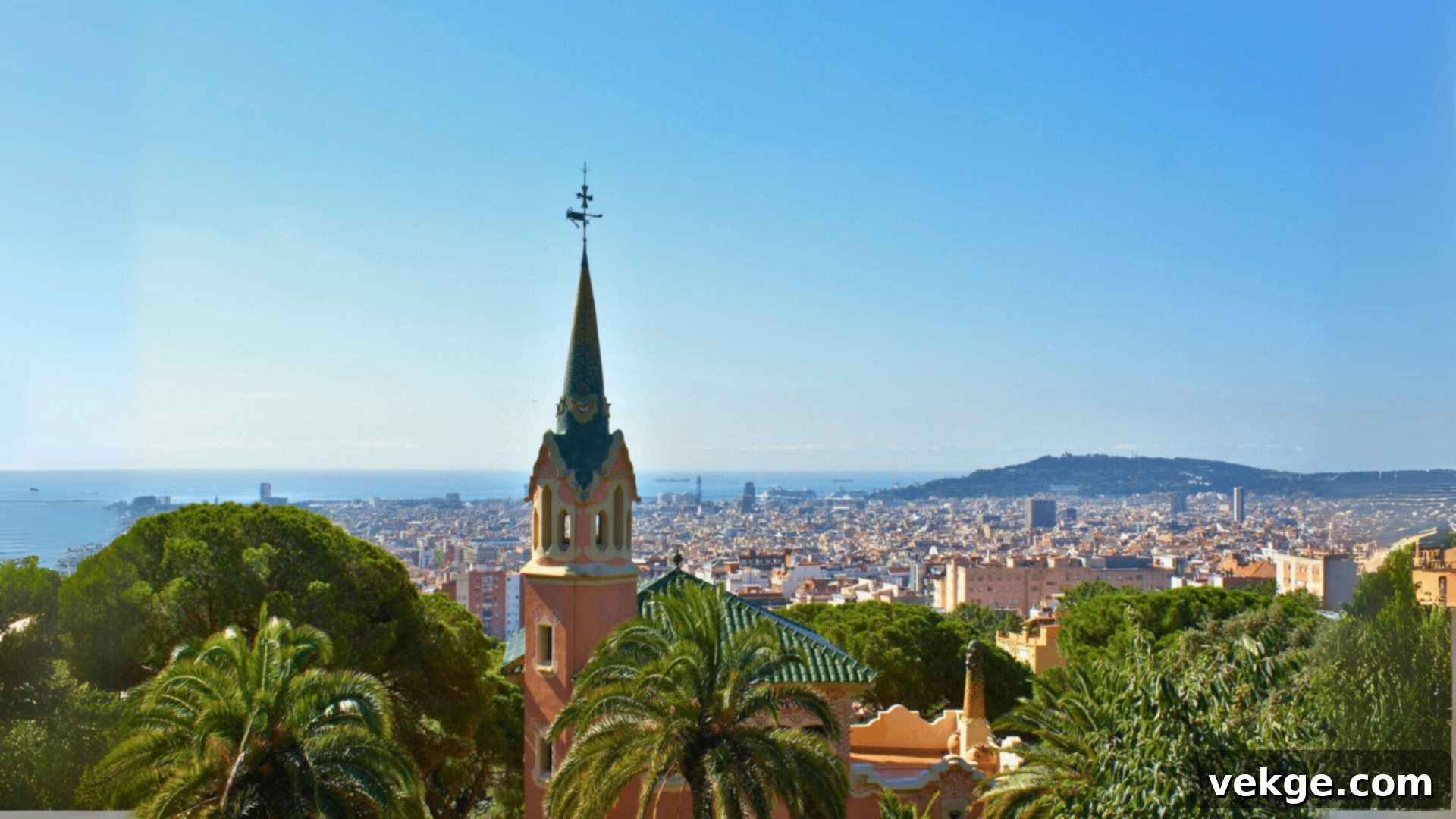
Gaudí’s public park is a whimsical landscape of architectural creativity, showcasing his unparalleled ability to blend art, nature, and urban design. Colorful mosaics, organic forms, and unique structural elements transform a simple park into an artistic wonderland and a truly immersive experience.
- Year built: Early 1900s
- Style: Gaudí’s Modernist landscape design
- Key feature: A vibrant, colorful mosaic park with unique architectural elements, including the famous dragon fountain and serpentine bench.
14. Plaza de España, Seville
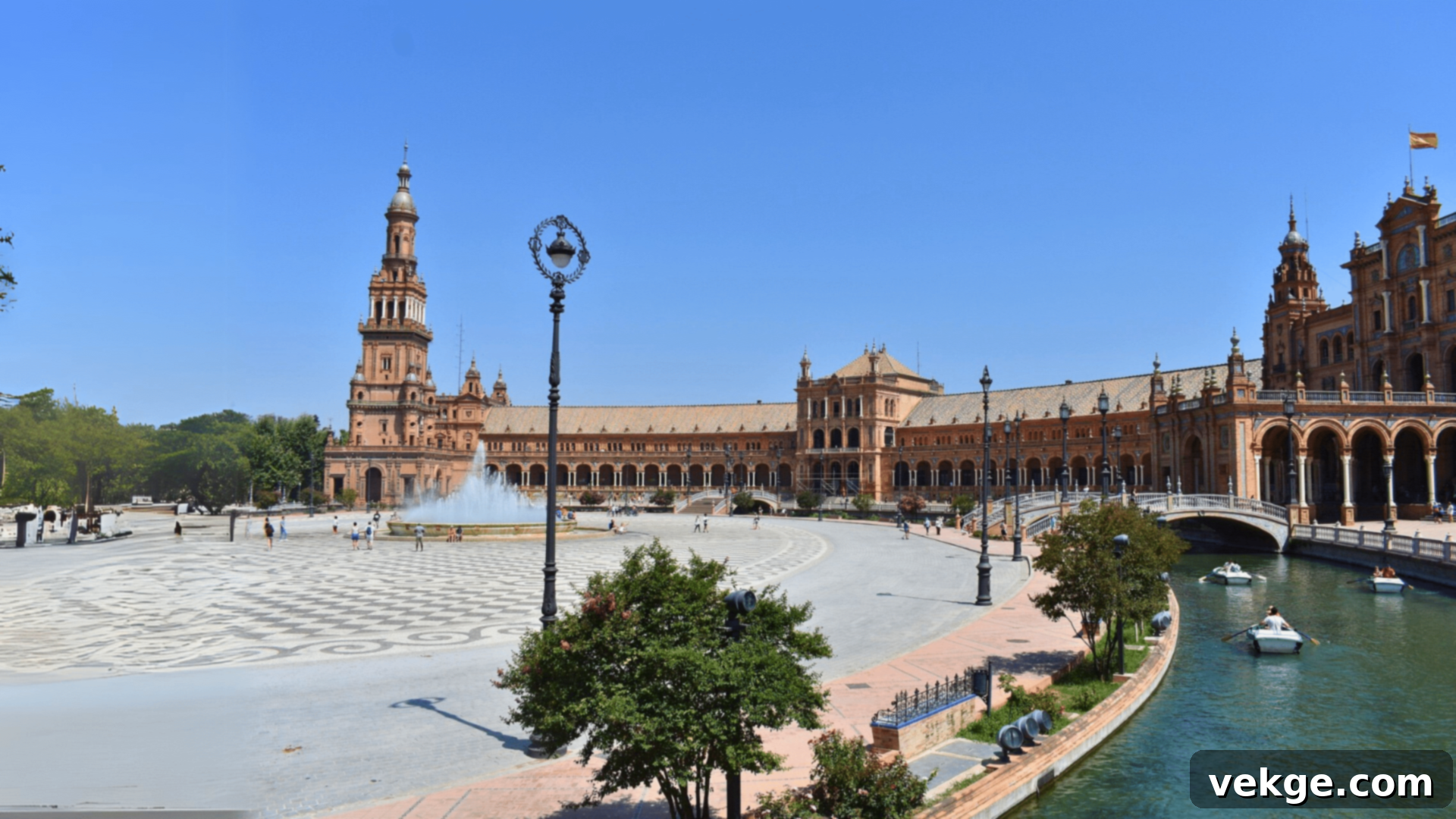
A grand architectural ensemble that magnificently showcases the beauty of Spanish Renaissance Revival style. Its massive semicircular design, intricate ceramic tiles representing each Spanish province, and picturesque bridges create a breathtaking and culturally rich urban space that once hosted the Ibero-American Exposition of 1929.
- Year built: 1920s
- Style: Renaissance Revival
- Key feature: A massive semicircular plaza adorned with beautiful ceramic tiles, canals, and bridges, celebrating Spanish regional diversity.
15. Burgos Cathedral
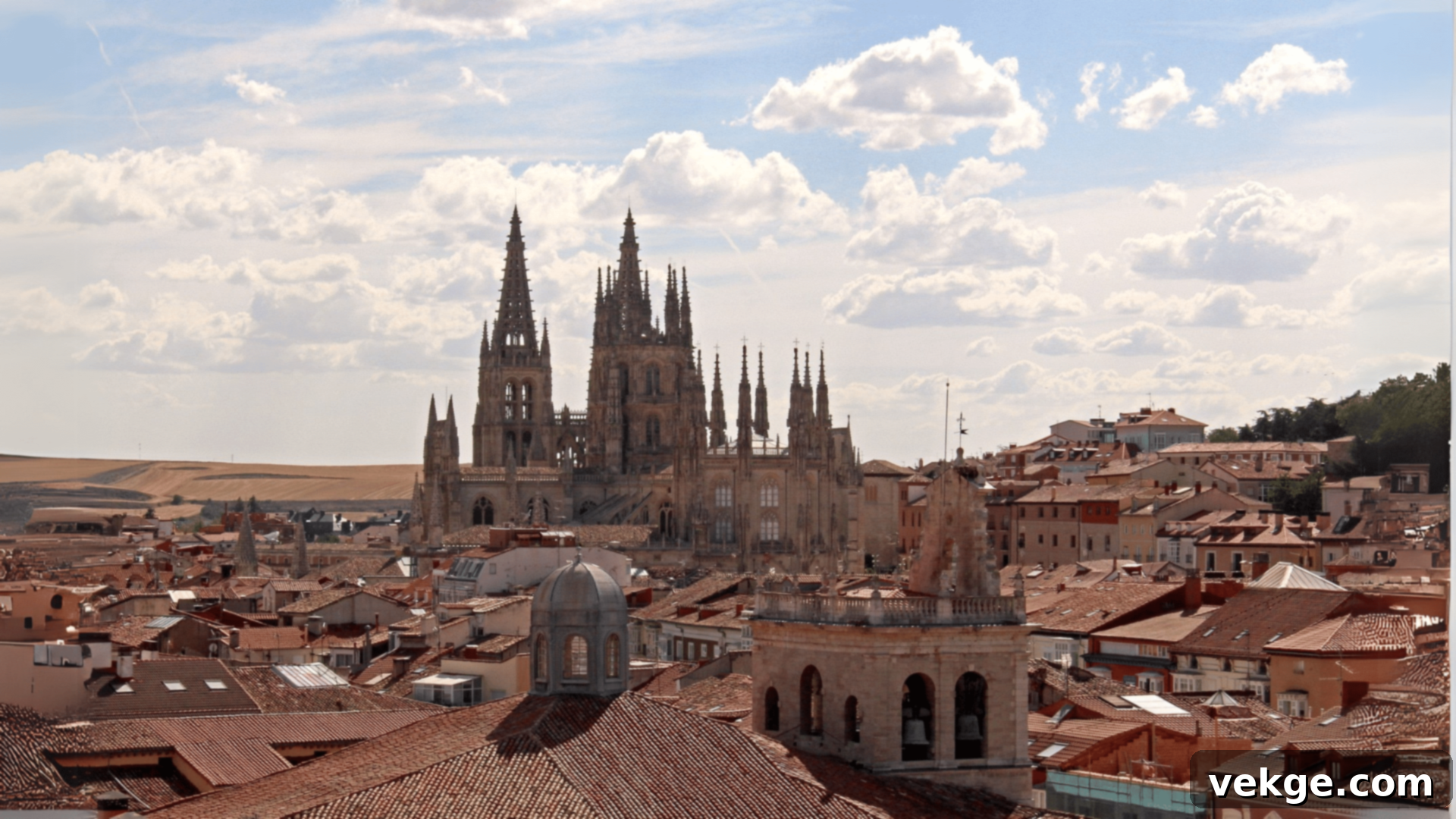
A pinnacle of Gothic architectural achievement, Burgos Cathedral is celebrated for its elaborate, lacelike stone carving and profound spiritual grandeur. Its incredibly detailed facade and towering spires tell stories in stone, earning it a place as a UNESCO World Heritage site and a jewel of Spanish Gothic art.
- Year built: 13th-16th century
- Style: Gothic style
- Key feature: An exquisitely detailed Gothic cathedral, known for its stunning spires, ornate chapels, and rich sculptural program.
16. Monastery of El Escorial
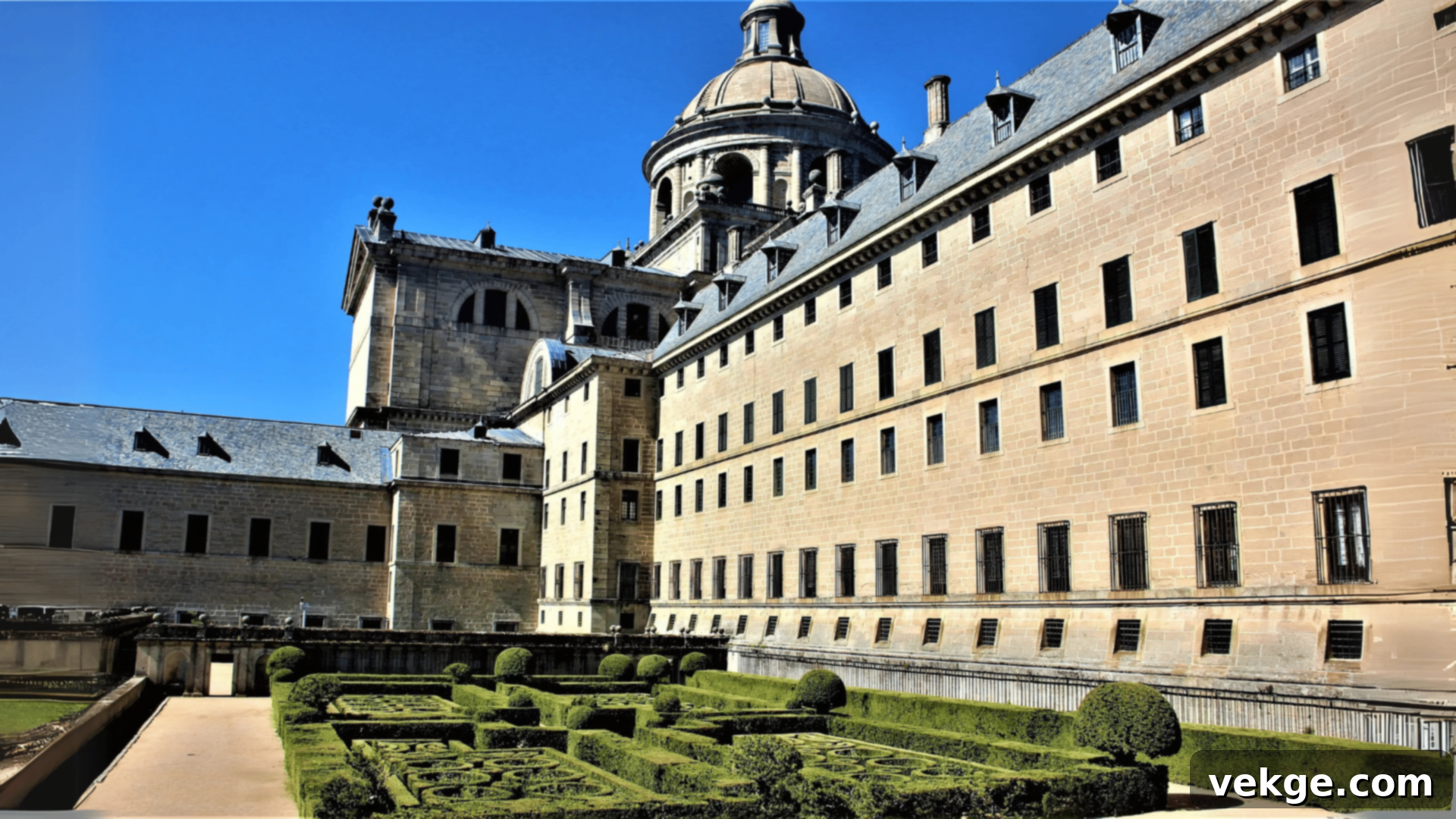
This massive complex combines a royal palace, a museum, a monastery, and a royal Pantheon, all under one roof. Its austere yet grand Renaissance architecture reflects the immense power, religious devotion, and cultural sophistication of Spain during its golden age, particularly under King Philip II.
- Year built: 16th century
- Style: Renaissance architecture
- Key feature: A vast, symmetrical complex combining palace, monastery, and royal burial site, representing the height of Spanish imperial power.
17. Barcelona Pavilion

A minimalist masterpiece that revolutionized modern architectural thinking, the Barcelona Pavilion remains an icon of 20th-century design. Designed by Ludwig Mies van der Rohe for the 1929 International Exposition, it represents the essence of modernist design principles: clean lines, open plans, and luxurious materials.
- Year built: 1929 (rebuilt 1986)
- Style: Modernist design
- Key feature: A minimalist masterpiece by Mies van der Rohe, celebrated for its simple elegance, open plan, and use of exquisite materials like marble, onyx, and chrome.
18. City Hall of Barcelona
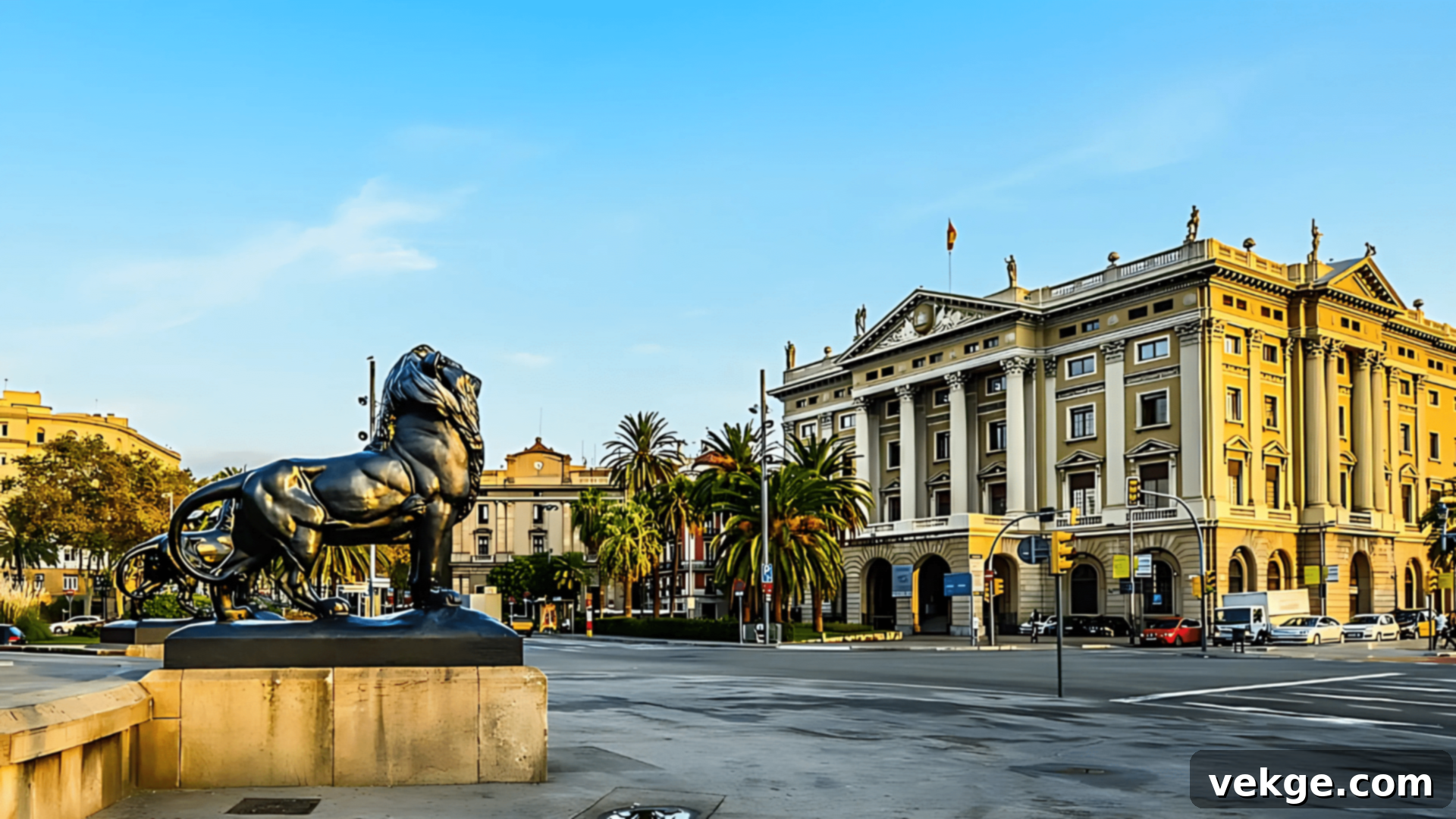
Located in the heart of Barcelona’s Gothic Quarter, the City Hall is a beautiful example of Catalan Gothic urban architecture that reflects Barcelona’s historical importance as a major Mediterranean trading power. Its medieval design, coupled with later neoclassical additions, continues to captivate visitors and residents alike.
- Year built: Gothic period (facade 14th-15th century), later additions
- Style: Gothic architecture (with Neoclassical facade)
- Key feature: A significant medieval building in the city center, showcasing a blend of Gothic and Neoclassical styles.
19. Roman Aqueduct of Segovia
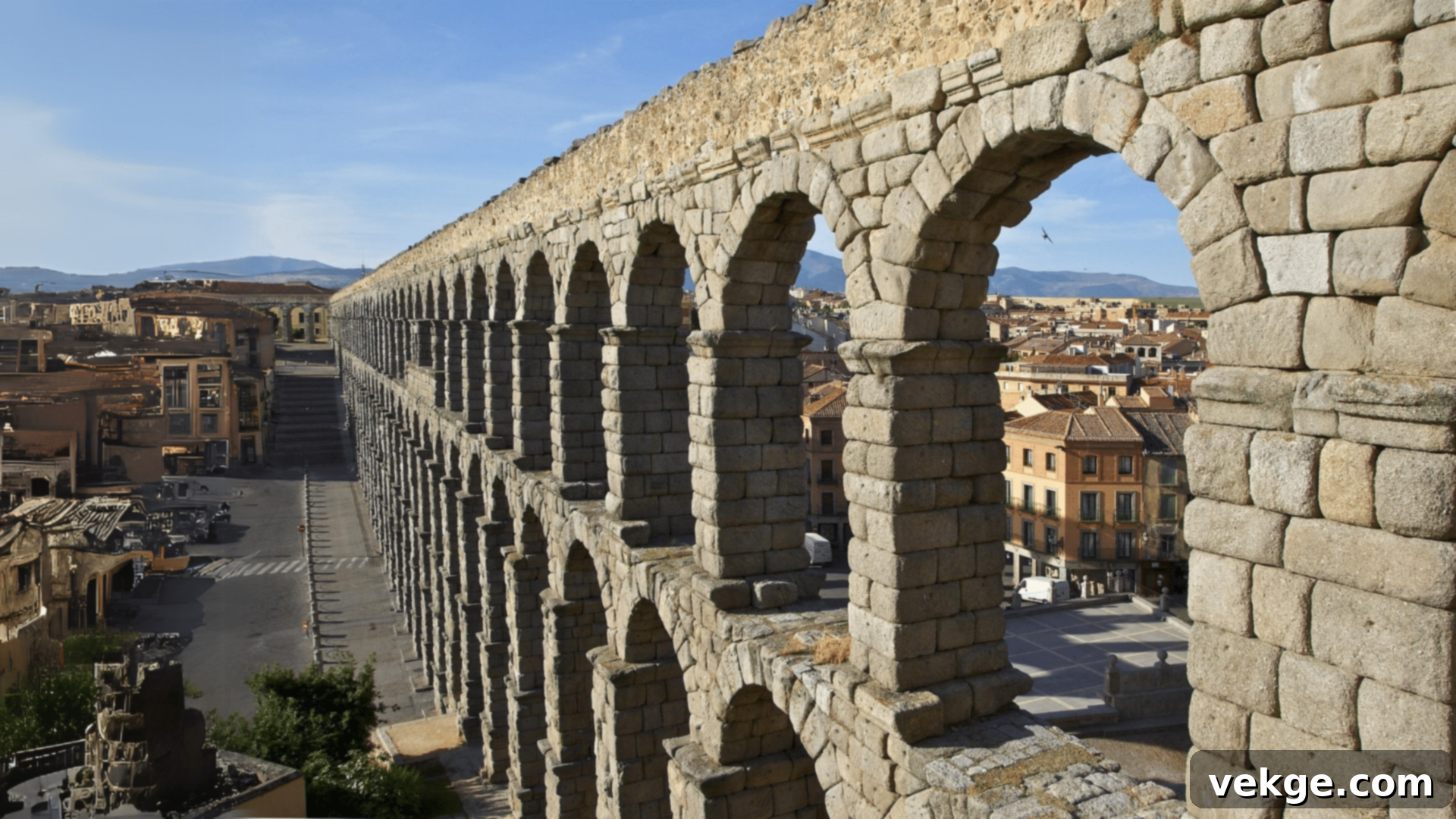
An incredible testament to Roman engineering that has majestically survived for nearly two millennia, the Aqueduct of Segovia is one of the best-preserved ancient Roman structures in the world. This monumental structure, built without mortar, demonstrates the advanced technical skills and enduring legacy of ancient builders, continuing to stand proudly in the city center.
- Year built: 1st-2nd century AD
- Style: Roman engineering
- Key feature: A perfectly preserved ancient water transport system, an astounding example of Roman ingenuity and construction.
20. New Museum of Contemporary Art, Barcelona (MACBA)
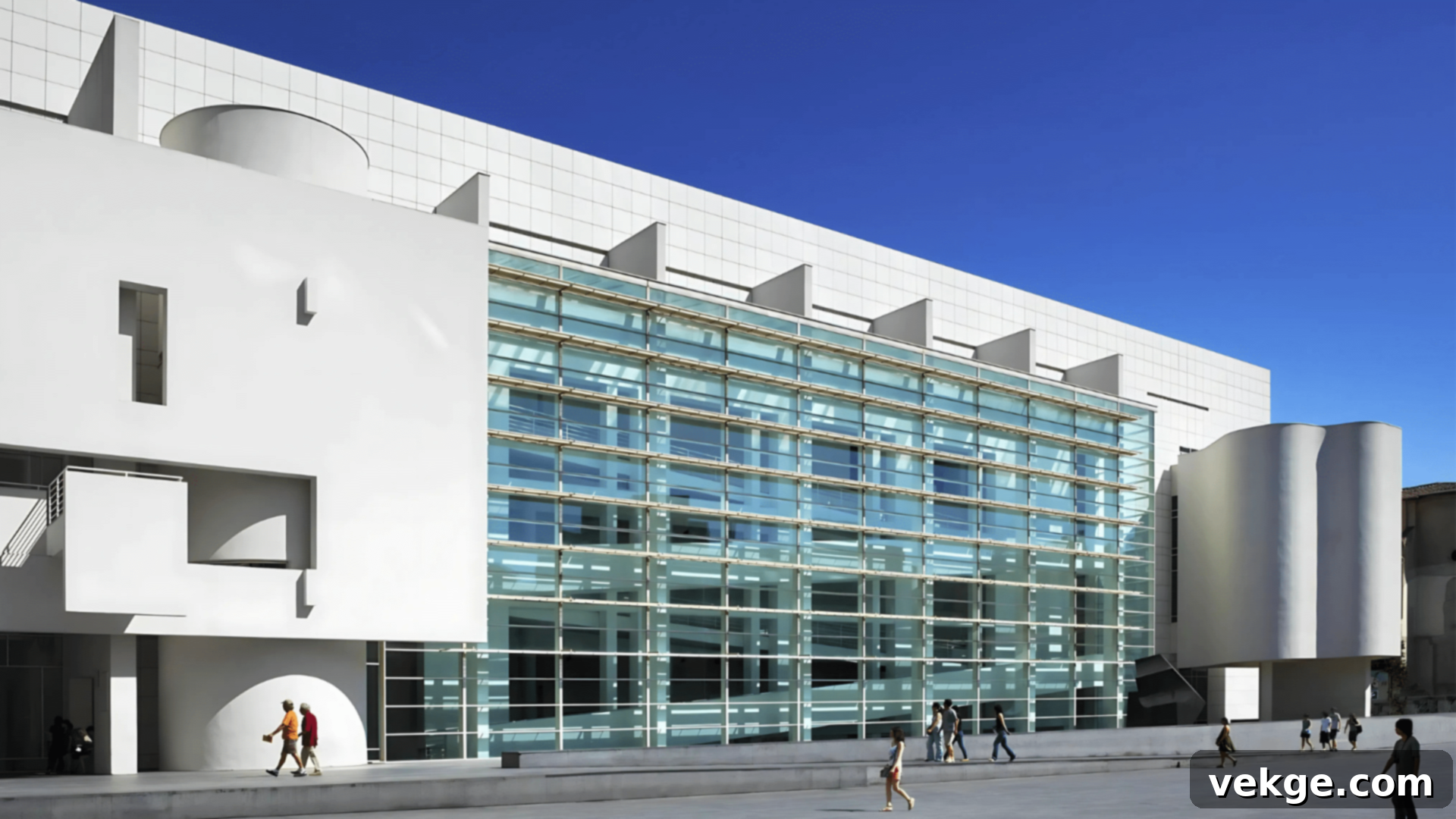
Designed by Richard Meier, MACBA is a striking modern architectural statement that represents the ongoing innovation and dynamism in Spanish design. Its bright, minimalist, and geometric contemporary approach perfectly reflects the vibrant and forward-thinking nature of Spanish creativity in the arts and architecture.
- Year built: 1995
- Style: Contemporary design
- Key feature: A striking modern museum with a bright, minimalist aesthetic, representing contemporary Spanish architectural innovation and artistic expression.
Top Architects Who Shaped Spain
Spain’s remarkable buildings are testaments to the brilliant minds and creative visions of architects who literally changed cityscapes and cultural perceptions. These visionary makers transformed humble stones and metals into living art that continues to speak to generations, blending tradition with groundbreaking innovation. Their work redefined how we perceive and interact with spaces, creating structures that transcend simple utility to become profound artistic statements. Each design reflects a deep connection to culture, history, and the human experience, leaving an indelible mark on Spain’s visual world. From wild imagination to meticulous planning, these creators have forged an unforgettable legacy.
- Antoni Gaudí: The most famous Spanish architect, Gaudí revolutionized design with his organic, flowing structures and vibrant use of color and texture. His iconic works in Barcelona, like the Sagrada Família and Casa Batlló, consistently challenge traditional architectural concepts, drawing inspiration from nature and religion.
- Santiago Calatrava: Known for his futuristic, sculptural, and often bridge-like designs, Calatrava creates buildings that evoke a sense of movement and often resemble living organisms. The City of Arts and Sciences in Valencia is his most prominent Spanish work, showcasing his unique vision of engineering and art.
- Rafael Moneo: A more understated architect, Moneo focuses on subtle, contextual designs that integrate seamlessly with their surroundings while maintaining a strong contemporary identity. He has created significant buildings worldwide, always respecting local architectural traditions and materials, exemplified by his extension to the Museo del Prado.
- Ricardo Bofill: An innovative architect known for his large-scale urban projects and unique residential designs, often characterized by monumental forms and a blend of classical and postmodern elements. His work frequently combines geometric precision with a grand, creative vision, notably seen in his “Walden 7” housing complex.
Architecture by Region in Spain
Spain’s architectural landscape is a rich tapestry woven from regional diversity and distinct cultural expressions. Each region tells a unique story through its buildings, reflecting local histories, deeply held traditions, and vibrant creative spirits. From the sun-drenched Mediterranean coast to the rugged northern mountains, the country’s structures eloquently capture the essence of local identities and the profound impact of historical changes, making every journey a discovery.
Barcelona & Catalonia
This region is an absolute paradise for architecture lovers, largely dominated by the visionary works of Antoni Gaudí and the wider Modernisme movement. Modernism flourishes here, with his iconic structures like the Sagrada Família and Park Güell instantly recognizable on the skyline. Beyond Gaudí, the Gothic Quarter, with its labyrinthine medieval streets and historical buildings, offers a profound step back in time, showcasing Barcelona’s rich and ancient architectural heritage.
Andalusia
In Andalusia, the legacy of Moorish architecture shines brightest, with the Alhambra in Granada standing as the undeniable peak of Islamic design in Europe. Its intricate tilework, tranquil courtyards, and stunning gardens make it an absolute must-see. The region also boasts other beautiful examples of Islamic and Christian architectural fusion, such as the unparalleled Mezquita in Córdoba and the magnificent Real Alcázar of Seville, which seamlessly blends various styles.
Madrid
Madrid, as the capital, offers a captivating blend of grand royal structures, stately squares, and cutting-edge modern designs. Historic palaces like the Royal Palace and the expansive Plaza Mayor sit alongside contemporary buildings, creating a vibrant and engaging architectural contrast. The city’s thoughtful urban planning integrates grand plazas, wide boulevards, and impressive museums, offering a dynamic mix of the old and the new.
Northern Spain
Northern Spain presents a fascinating mix of ancient history and bold modernity. The centuries-old, historic Santiago de Compostela Cathedral stands in striking contrast to the avant-garde Guggenheim Museum in Bilbao. This region proudly showcases a wide range of architectural styles, from well-preserved medieval buildings and Romanesque churches to innovative contemporary designs, providing a rich and incredibly diverse experience for architecture enthusiasts.
Conclusion
Spain’s architectural history is far more than a collection of mere buildings; it’s a vibrant narrative woven into the very fabric of its land. We’ve journeyed through centuries of creative expression, from the enduring strength of ancient Roman walls to the breathtaking innovation of modern wonders. Each structure we’ve encountered tells a unique human story, reflecting not just historical events but also how people connect, adapt, and dream across different eras and cultures.
Our tour has touched upon diverse regions, distinct styles, and pivotal historical moments, revealing how cultures mix, clash, and ultimately create something enduringly beautiful. Visionary creators like Gaudí didn’t just construct buildings; they fundamentally changed how we perceive and interact with architectural spaces, inviting us to see the world anew.
The next time you gaze upon a building, particularly one in Spain, remember: it is more than just walls and a roof. It is a living memory, a tangible echo of human creativity, passion, and resilience. Spain’s architecture invites us to experience the world through a lens of wonder and profound connection, reminding us of the timeless artistry that shapes our shared heritage.
